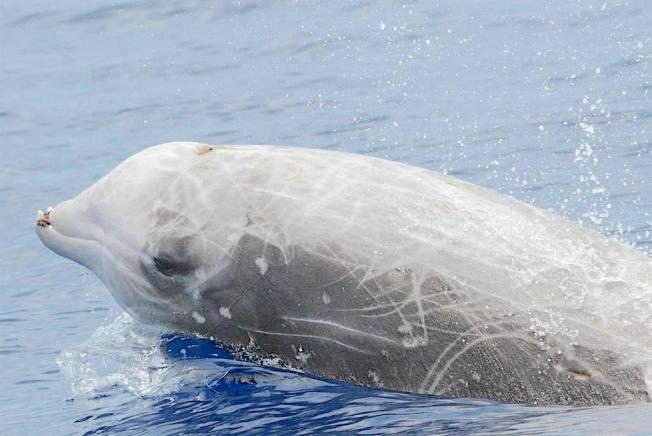CUVIER’S BEAKED WHALE
‘DEEP DIVERS IN DIVERS DEEPS’: CUVIER’S BEAKED WHALES
JOURNEY TO THE WORLD’S MIDNIGHT ZONE
Please join me in a dive down from the sparkling surface of the turquoise sea to the twilight zone at 200 meters. You’ll pass plenty of sea-life on the way: manatees grazing on seagrass just below the surface; reef fish, barracudas, reef sharks, mahi-mahi, maybe an orca at 100 meters. Other familiar creatures that are found even lower include a few reef fish, some shark species and green sea turtles. You are now running out of clear light.
As you descend from 200 meters the waters become murky, then inky. The variety of inhabitants and their numbers are gradually decreasing. There are eels, some sharks, squid, stranger deep-water creatures. You may be surprised to see familiar bottlenose dolphins, recorded as diving nearly 300 meters. At 332 meters you will equal the deepest point any human being has ever scuba-dived (Ahmed Gabr 2014). There is little light, but you still have a long way to go to reach your goal.
Descending still deeper, species and numbers continue to thin out. Around the world the limits of larger recognisable species is being reached – more shark species, tuna, chinook salmon, emperor penguins, swordfish, the few corals that can survive the depth. As the light fades to black, giant creatures and strange fish abound. Huge crabs. Sunfish. The (no-longer-extinct) Coelocanth. Massive octopuses.
Deeper down, nearing 1000 meters now, there are still some familiar species. Leatherback turtles; Baird’s beaked whales (nb not in the Atlantic); and at 920 meters, the deepest recorded sperm whale dive. It’s pitch dark: you have reached the level that sunlight never penetrates. You are in the Midnight Zone.
DEEP OCEAN DWELLERS
In black depths below 1000 meters, creatures have adpated to create their own light sources – so-called bioluminescence. This is the realm of the self-lit anglerfish, the blobfish and the goblin shark. It’s the Attenborough world of deep sea exploration. The geology is changing: there are hypervents, volcanic rocks, heavy metals. Below are the deep ocean-floor trenches. Yet there are still recognisable species down here, diving astonishingly deep to 1800 meters to feed – not least the narwhal which makes this trip several times a day to feed.
We need to quicken up the descent now – we have to get down nearly twice as far as this to reach our destination…
We pass large squid and isopods, the deepest diving shark – the Greenland, the 10 meter-long 700 kilo colossal squid – yet amazingly there are marine mammals yet to be encountered: at 2400 meters we drift past a huge elephant seal. There are evil-looking creatures down here with names to match – devilfish, viperfish, black swallowers that can eat a larger fish whole, vampire squid and zombie worms.
At 3000 feet, we finally end our quest. We have reached the depth to which the world’s deepest diving mammal has been recorded: the Cuvier’s beaked whale Ziphius cavirostris
Cuvier’s beaked whales, or “goose-beaked whales,” are not rare. For a start, unlike many beaked whale species, they inhabit most oceans and seas in the world and have the most extensive range. Unsurprisingly therefore, they are one of the most often sighted beaked whale species and one of the best studied.
The Cuvier’s is one of the 3 beaked whale species found in Bahamas waters. Like the rarer Blainville’s and Gervais’s beaked whales, the Cuvier’s is the subject of ongoing research by the BAHAMAS MARINE MAMMAL RESEARCH ORGANISATION BMMRO.
The research into marine mammal populations in the Bahamas and far beyond is focussed on the massive increase in single and mass strandings, including recently in a remote area of Scotland (Hebrides) where more than 40 Cuvier’s were washed ashore.
One significant area of research examines the effect on marine mammals of man-made noise. There is plenty of it in the world’s oceans caused by noise pollution in and around shipping channels that traverse marine mammal migration, feeding and breeding grounds; naval surface and submarine exercises; seismic surveys, sonar waves and undersea resource investigations. The evidence of sound / acoustic damage as an additional hazard for marine mammals is starting to look very clear.
DEEP WATER INFOGRAPHIC
Do not miss this wonderful work by Neal Agarwal. This article is based around it and includes facts and images derived from his incredibly complex structure that has resulted in a remarkably simple resource for layman and ocean-lover alike (I realise these categories may overlap). To see the entire masterpiece, double click of the box below – “it will be worth it”.
CREDITS: Neal Agarwal; BMMRO / Charlotte Dunn; M.Rosso GIMA – IUCN; NOAA Fisheries; BW – Getty – Times; general sources – BMMRO, IUCN, NOAA, WDC
Georges Cuvier, a French naturalist and biologist, was born 1770. His scientific expertise lay in the comparison of living animals and fossils. He was the leading light in the establishment and development of the fields of comparative anatomy and palaeontology.
As ever, the Bahamas Philatelic Bureau has produced a wonderful stamp special issue



















